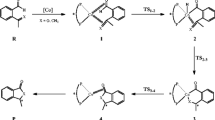Abstract
The regio- and stereoselectivities of the hydroformylation reaction catalyzed by an unmodified Rh catalyst have been investigated at the B3P86/6-31G* level with Rh described by effective core potentials in the LANL2DZ valence basis set for a number of either mono- or (1,1-, 1,2-, 1,3-) di-substituted substrates and compared with a variety of earlier results of ours, supplemented with free energy results when not already available. The computational prediction of regio- and stereoselectivities in nonreversible hydroformylations performed under mild reaction conditions is seemingly possible provided a careful conformational search for TS structures is carried out and all the low energy conformers are taken into account. The internal energy can be used to compute both the regio- and stereoselectivities in the hydroformylation of 1,1- and 1,3-substituted substrates with satisfactory results, whereas for 1,2-substituted substrates the regioselectivity determined from the internal energy is in good agreement with the experiment in the case of aliphatic olefins just for the lowest terms in the series (i.e., methyl and ethyl substituents), while the ratios are only qualitatively correct for the slightly bulkier iso-propyl and tert-butyl moieties. The theory/experiment agreement becomes decidedly better using the free energy differences instead.








Similar content being viewed by others
Notes
Actually a chiral center appears in the hydroformylation of a nonchiral substrate when R (Scheme 1) is an alkyl group greater than CH3 or an aromatic group; the hydroformylation with unmodified rhodium catalysts however produces the racemic branched aldehydes without any stereoselectivity. In contrast, when the substrate is a chiral olefin itself, diastereoselectivity might originate as shown for two 1,3-substituted olefins in Scheme 2; notice that in such cases the total branched population is used to obtain the regioselectivity, because \( {\hbox{b}} + {\hbox{b}}\prime = {\hbox{B}}. \)
The SBK(d) basis set is described in detail in Ref. 11.
In those cases, 36 complex structures can be obtained, nine for each type (b, b’, l, l’). Taking into account the possible switch of the apical CO, as we did, the total number becomes 72.
For the productories, both the B and L values are reported without an identical 10n factor.
References
Anh NT, Eisenstein O (1977) Nouv J Chim 1:61–70
Houk KN (2000) Theor Chem Acc 103:330–331
Koga N, Jin SQ, Morokuma K (1988) J Am Chem Soc 110:3417–3425
Matsubara T, Koga N, Ding Y, Musaev DG, Morokuma K (1997) Organometallics 16:1065–1078
Gleich D, Schmid R, Herrmann WA (1998) Organometallics 17:4828–48347
Rocha WR, De Almeida WB (1998) Organometallics 17:1961–1967
Torrent M, Solà M, Frenking G (2000) Chem Rev 100:439–493
Rocha WR, De Almeida WB (2000) Int J Quantum Chem 78:42–51
Rocha WR, De Almeida WB (2000) J Comput Chem 21:668–674
Carbó JJ, Maseras F, Bo C, van Leeuwen PWNM (2001) J Am Chem Soc 123:7630–7637
Decker SA, Cundari TR (2001) Organometallics 20:2827–2841
Alagona G, Ghio C, Lazzaroni R, Settambolo R (2001) Organometallics 20:5394–5404
Decker SA, Cundari TR (2002) New J Chem 26:129–135
Landis CR, Uddin J (2002) J Chem Soc, Dalton Trans:729-742
Alagona G, Ghio C, Lazzaroni R, Settambolo R (2004) Inorg Chim Acta 357:2980–2988
Rocha WR (2004) J Mol Struct THEOCHEM 677:133–143
Gleich D, Hutter J (2004) Chem Eur J 10:2435–2444
Luo M, Tang D, Li M (2005) Int J Quantum Chem 105:108–123
Alagona G, Ghio C (2005) J Organomet Chem 690:2339–2350
Settambolo R, Rocchiccioli S, Lazzaroni R, Alagona G (2006) Lett Org Chem 3:10–12
Sparta M, Børve KJ, Jensen VR (2007) J Am Chem Soc 129:8487–8499
Alagona G, Ghio C, Rocchiccioli S (2007) J Mol Model 13:823–837
Ghio C, Lazzaroni R, Alagona G (2009) Eur J Inorg Chem:98-103
Shaharun MS, Dutta BK, Mukhtar H (2009) AIChE J 55:3221–3233
Tang D, Zhang Y, Hu C (2009) Chin J Chem 27:81–87
Lazzaroni R, Settambolo R, Alagona G, Ghio C (2010) Coord Chem Rev 254:696–706
Da Silva JCS, Dias RP, De Almeida WB, Rocha WR (2010) J Comput Chem 31:1986–2000
McQuarrie DA (2000) Statistical mechanics. University Science Book, Sausalito, CA
Frisch MJ, Trucks GW, Schlegel HB, Scuseria GE, Robb MA, Cheeseman JR, Montgomery JA, Vreven T, Kudin KN, Burant JC, Millam JM, Iyengar SS, Tomasi J, Barone V, Mennucci B, Cossi M, Scalmani G, Rega N, Petersson GA, Nakatsuji H, Hada M, Ehara M, Toyota K, Fukuda R, Hasegawa J, Ishida M, Nakajima T, Honda Y, Kitao O, Nakai H, Klene M, Li X, Knox JE, Hratchian HP, Cross JB, Bakken V, Adamo C, Jaramillo J, Gomperts R, Stratmann RE, Yazyev O, Austin AJ, Cammi R, Pomelli C, Ochterski JW, Ayala PY, Morokuma K, Voth GA, Salvador P, Dannenberg JJ, Zakrzewski VG, Dapprich S, Daniels AD, Strain MC, Farkas O, Malick DK, Rabuck AD, Raghavachari K, Foresman JB, Ortiz JV, Cui Q, Baboul AG, Clifford S, Cioslowski J, Stefanov BB, Liu G, Liashenko A, Piskorz P, Komaromi I, Martin RL, Fox DJ, Keith T, Al-Laham MA, Peng CY, Nanayakkara A, Challacombe M, Gill PMW, Johnson B, Chen W, Wong MW, Gonzalez C, Pople JA (2004) Gaussian 03, Revision C.02. Gaussian Inc, Wallingford, CT
Becke AD (1993) J Chem Phys 98:5648–5652
Perdew JP (1986) Phys Rev B 33:8822–8824
Hehre WJ, Radom L, PvR S, Pople JA (1986) Ab initio molecular orbital theory. Wiley, New York
Hay PJ, Wadt WR (1985) J Chem Phys 82:270–283
Lee C, Yang W, Parr RG (1988) Phys Rev B 37:785–789
Lazzaroni R, Settambolo R, Alagona G, Ghio C (manuscript in preparation)
Miller WH (1979) J Am Chem Soc 101:6810–6814
Rocchiccioli S (2006) Substrate-induced Diastereoselectivity in Rhodium-Catalyzed Hydroformylation. PhD Thesis, University of Pisa
van Leeuwen PWNM, Casey CP, Whiteker GT (2000) in Rhodium Catalyzed Hydroformylation; van Leeuwen PWNM, Claver C (eds) Kluwer CMC, Dordrecht, The Netherlands, p 96
Alagona G, Ghio C (manuscript in preparation)
Author information
Authors and Affiliations
Corresponding authors
Additional information
An erratum to this article can be found at http://dx.doi.org/10.1007/s00894-012-1373-8.
Rights and permissions
About this article
Cite this article
Alagona, G., Lazzaroni, R. & Ghio, C. Computational prediction of selectivities in nonreversible and reversible hydroformylation reactions catalyzed by unmodified rhodium-carbonyls. J Mol Model 17, 2275–2284 (2011). https://doi.org/10.1007/s00894-010-0864-8
Received:
Accepted:
Published:
Issue Date:
DOI: https://doi.org/10.1007/s00894-010-0864-8




